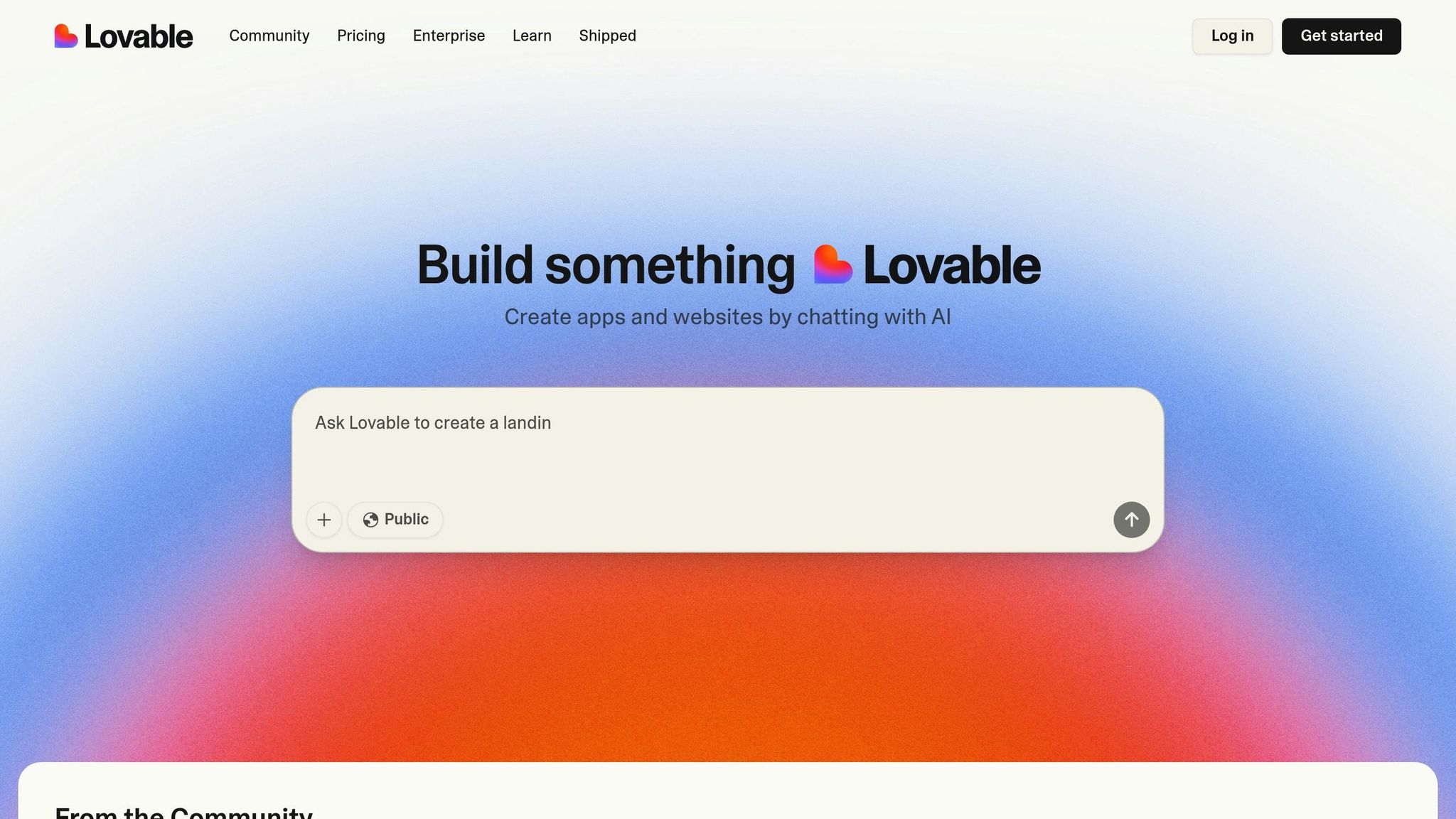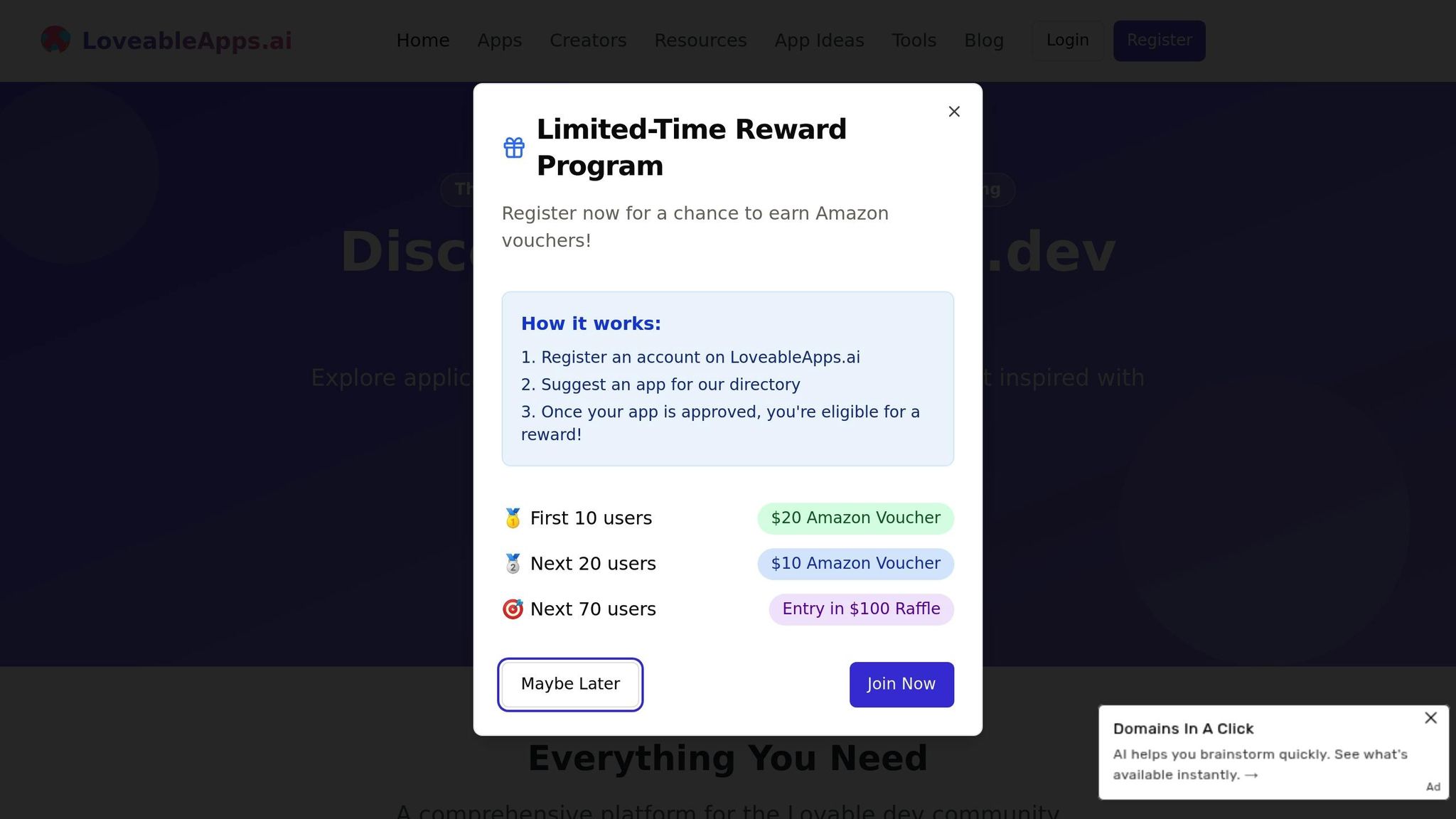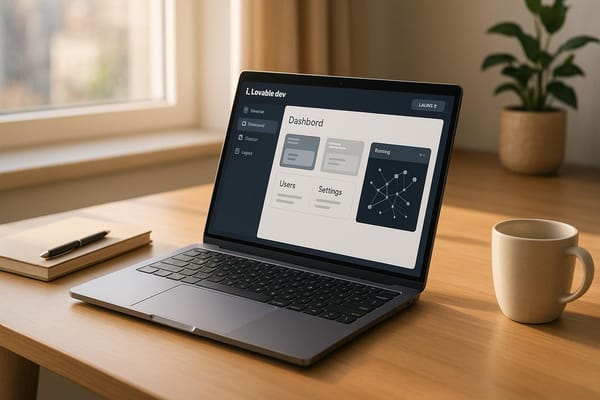Case Study: User Needs in a Loveable.dev MVP
Explore how an AI-driven platform helped a team create a productivity app MVP by focusing on user needs and rapid iteration.

Building an MVP that users love starts with solving real problems. This case study explores how a team used Loveable.dev, an AI-driven platform, to quickly create a productivity app MVP that addressed small business owners' key pain points. The team focused on user needs, streamlined development with natural language prompts, and iterated based on feedback.
Key takeaways:
- User-focused research: The team identified core problems like scattered information, delayed updates, and complex reporting through interviews, surveys, and prototypes.
- Targeted features: They delivered a unified dashboard, automated progress tracking, and one-click reports.
- AI-powered development: Loveable.dev accelerated the process by generating full-stack code from simple prompts, enabling rapid testing and iteration.
- Iterative improvements: User feedback led to simplified interfaces, smarter alerts, and better navigation.
This approach highlights the importance of understanding user needs and leveraging AI tools for efficient MVP development.
How to Get Valuable Feedback from Your MVP?
How to Find User Needs for Your MVP
When the team behind this productivity app set out to create their MVP, they focused on solving real problems for small business owners instead of relying on assumptions. Their research revealed a common struggle: managing multiple tools to track project progress, which often led to confusion and inefficiency.
Research Methods for Understanding Users
To truly grasp their audience's needs, the team used several research methods. They started with in-depth customer interviews to uncover genuine pain points. These conversations revealed that business owners didn’t want another overly complex project management tool. What they needed was something simple - a tool that could quickly show project status without requiring extensive training or setup.
Next, they tested their concept by creating a landing page to gauge market interest. By analyzing visitor behavior, they validated that their idea resonated with potential users.
They also ran quick social media polls in professional groups on LinkedIn and Facebook. These short surveys highlighted key frustrations, such as the hassle of having project data scattered across different tools.
Additionally, the team used paper prototypes to test dashboard layouts in informal settings. This allowed them to gather feedback on what users valued most and how they preferred navigating between views. These insights laid the groundwork for turning identified challenges into actionable features.
Turning Problems into Features
The research uncovered three major challenges: scattered information, delayed status updates, and difficulty in communicating progress to clients. The team translated these issues into focused features:
- Unified dashboard: To consolidate updates from multiple tools and address the issue of scattered information.
- Automated progress tracking: With visual indicators to alert users when projects were falling behind, tackling the problem of delayed updates.
- One-click report generator: For creating clean, branded status updates, making client communication faster and easier.
The guiding principle was to focus on solving core problems. Users didn’t need a feature-packed system - they needed quick, clear answers to the question, “How are my projects doing?”
Mapping User Needs to Features
The insights from their research directly shaped the MVP’s feature set. Each user need was tied to a specific feature, ensuring every addition solved a real problem. Here’s how they mapped it out:
| User Need | Specific Problem | MVP Feature | Expected Outcome |
|---|---|---|---|
| Quick project overview | Switching between multiple tools | Unified dashboard | Simplified workflow with fewer tools required |
| Early problem detection | Discovering issues too late | Automated status alerts | Faster identification of project delays |
| Professional client updates | Time-consuming report creation | One-click report generator | Quicker, more consistent client communication |
The team used Loveable.dev’s AI tools to streamline the development process. By providing simple natural language prompts like, “Create a dashboard with green, yellow, and red indicators and generate PDF client reports,” the platform’s AI translated these instructions into functional code. This approach enabled rapid development and testing of their MVP.
Ultimately, the team showed that understanding user needs doesn’t require exhaustive market research. Instead, it’s about engaging directly with users to transform real problems into simple, effective solutions. By focusing on essential features, they created an MVP that users quickly embraced.
Building the MVP with Loveable.dev

After identifying user needs, the team quickly turned their insights into a functional MVP using Loveable.dev's AI-powered platform. This approach removed many of the typical roadblocks in early-stage development, enabling a smooth transition from planning to execution. With AI handling both front-end and back-end tasks, they were able to move at an impressive pace.
Using AI-Powered Development Tools
To speed up the process, the team relied on AI-driven tools that simplified coding. Instead of manually writing code, they used natural language prompts to describe the features they wanted. For instance, when creating the unified dashboard, they instructed the AI with a simple command: "Build a project status dashboard with green, yellow, and red indicators that update automatically as milestones change." The platform instantly generated the dashboard, allowing them to preview and tweak it in real time.
Prototyping became incredibly efficient, too. When debating between a card-based layout and a list view for displaying project statuses, the team used the AI to generate both designs within minutes. This allowed them to test user preferences quickly and make informed design decisions.
Responsive design was another area where the platform excelled. Without any extra effort, the interface adapted seamlessly to both desktop and mobile screens, saving the team countless hours of manual adjustments.
Adding Core Functions
With the front-end established, the team moved on to integrating essential backend features. Loveable.dev streamlined this process by combining front- and back-end development in a single environment. They connected databases through Supabase, set up API integrations with project management tools, and managed version control via GitHub - all without needing multiple tools or complex configurations.
Improving Based on User Feedback
Throughout development, the team kept user feedback at the forefront. They engaged the same business owners who had provided input during the research phase, ensuring the product stayed aligned with real-world needs. This feedback loop revealed areas for improvement, such as overly sensitive alerts and navigation challenges. Fixing these issues was straightforward - simple AI prompts adjusted notification settings and reworked the user flow.
Thanks to Loveable.dev's adaptable environment, the team could implement changes in days rather than weeks. This iterative process kept the project on schedule while ensuring the final product addressed user needs effectively. By launch, the MVP was not only functional but also aligned with user expectations.
Measuring User Response and Improving the MVP
After launching the MVP, the team zeroed in on tracking how users interacted with their project management dashboard. This step was vital in uncovering gaps between what users expected and what they actually experienced.
Launch Results and User Activity
During the first week post-launch, the team monitored key metrics like acquisition rate (page visitors and bounce rates), conversion rate (active users), and retention rate (how long users stayed engaged). While many users completed the initial setup, fewer returned for follow-up sessions, and the churn rate was higher than anticipated. Usage data showed that the unified dashboard - the MVP’s standout feature - saw strong initial engagement but declined over time. Meanwhile, the automated alert system received mixed reviews: some users appreciated the notifications, but others disabled them shortly after signing up. These findings laid the groundwork for gathering deeper user insights.
Collecting and Analyzing User Feedback
To address the gap between initial interest and long-term engagement, the team adopted several feedback collection methods. They built in-app feedback forms directly into the dashboard, making it easy for users to report issues and suggest changes. Additionally, they reached out through social media and conducted brief phone interviews with users who had stopped using the platform. Surveys highlighted key pain points: users felt overwhelmed by too many status indicators, found the alert system overly sensitive, and struggled with navigation issues like locating the settings panel or customizing project categories.
What We Learned and How We Improved
User feedback became the foundation for targeted updates, which were implemented using Loveable.dev's development tools. One major improvement was simplifying the main dashboard by cutting down on visual clutter and logically grouping related information. AI-based prompts helped guide interface redesigns, and iterative layout tests ensured smoother navigation.
The alert system also underwent significant changes. Smart filtering was introduced, so notifications now focus only on critical milestones and overdue tasks - directly addressing user concerns.
A great example of successful iteration comes from Sarah Chen, who used Loveable.dev to refine TaskFlow, her app for freelancers. Feedback revealed that users found the automation suggestions confusing and some features incomplete. Sarah utilized Loveable.dev’s Chat Mode and Visual Edits tools to redesign the dashboard and improve navigation. She also integrated Supabase to fix backend issues and used AI-powered Retrieval-Augmented Generation to optimize database queries. These updates boosted the app's functionality from 60–70% to over 90%, reducing user errors by 30% and increasing task completion rates.
These iterative updates highlight the importance of staying connected with users, especially during the early stages of adoption.
Key Lessons and Best Practices
This case study ties the hurdles faced during MVP development to actionable strategies that can help build successful products using Loveable.dev.
Main Lessons from This Case Study
User feedback is the cornerstone of improvement. The project management dashboard example highlighted how initial assumptions about user needs can fall short. While the unified dashboard initially caught users' attention, issues like visual clutter and overly sensitive alerts eventually hurt long-term engagement. This gap between initial interest and sustained usability emphasizes the need for ongoing user feedback.
Simplicity wins over complexity. Overly intricate interfaces tend to overwhelm users and make navigation difficult. By focusing on core functionality, you can ensure your MVP stays practical and user-friendly.
AI-powered iteration is a game-changer. Sarah Chen’s work on TaskFlow showed how AI-driven improvements can significantly enhance functionality, boosting it from 60-70% to over 90%. These lessons naturally set the stage for best practices when using Loveable.dev to build MVPs.
Best Practices for Building MVPs on Loveable.dev
- Start with clear, specific instructions. This ensures Loveable.dev can effectively translate your vision into code.
- Prioritize core features. Focus on solving high-impact problems and avoid unnecessary complexity.
- Follow a structured workflow. Use a clear process - plan, prompt, scaffold, debug, and deploy - to maintain order during development. Chat Mode is especially useful for brainstorming ideas before transitioning to Edit Mode for implementation.
- Thoroughly test before launch. Loveable.dev’s built-in tools make it easy to identify and fix issues early.
- Monitor performance closely. Use built-in analytics tools to track user behavior and address issues as they arise.
- Emphasize version control and collaboration. These are critical for refining your product based on user feedback.
As Marius from Veloxforce explains:
"Lovable empowers me to create frontends that surpass my own technical limitations. It allows me to swiftly develop prototypes to showcase to clients, without the need for generic templates or starting from scratch. Essentially, it enables me to concentrate on the backend while GPT Engineer efficiently generates a functional and visually appealing frontend my clients will love."
Using Loveableapps.ai for Learning and Inspiration

To support your development journey, Loveableapps.ai serves as a hub for resources within the Loveable.dev ecosystem. Here’s what it offers:
- App Directory: A collection of real-world applications built with Loveable.dev.
- Creator Showcase: A platform to connect with developers behind successful projects.
- Learning Resources: Tutorials, guides, and courses tailored to Loveable.dev.
- App Ideas: A source of inspiration for your next project.
Martin from Platanus shares his experience:
"I'm always amazed at how fast we can whip up a UI With Lovable AI. It gives me a solid base that I can easily tweak and build on. Plus, using it to integrate it with the backend is magical!"
FAQs
How did Loveable.dev's AI tools improve the development of the MVP for the productivity app?
Loveable.dev's AI tools were a game-changer for accelerating the MVP development of the productivity app. By automating intricate coding tasks, these tools allowed developers to build a working prototype in just hours instead of weeks. This gave small teams and indie creators the freedom to concentrate on refining their concepts and testing them with real users.
Key features like natural language prompts and automated code generation made both frontend and backend development much more straightforward. This approach not only cut down development time but also enabled rapid iterations, making it possible to turn fresh ideas into functional solutions without needing deep technical expertise. The outcome? A quicker, smoother journey to a polished MVP.
How did the team ensure their MVP effectively met user needs?
The team adopted a mix of strategies to ensure their MVP genuinely met user needs. By utilizing Lovable.dev's AI-powered tools, they significantly sped up the development process, enabling them to create and test MVPs up to 20 times faster. This rapid pace gave them the chance to quickly gather user feedback and make improvements without delay.
They also took an early validation approach by setting up professional landing pages. These pages helped them gauge user interest and even collect pre-orders, ensuring the product was built to meet actual demand. This strategy kept their efforts laser-focused on addressing real user problems, resulting in an MVP that was practical and user-focused.
How did user feedback shape improvements to the MVP after its launch?
User feedback played a key role in shaping the Loveable.dev MVP. Early adopters shared insights that led to noticeable improvements in the app's usability, making it easier and more intuitive to navigate. Their input also influenced upgrades in performance and security, helping the app align more closely with user needs and expectations. These ongoing updates underscore how essential it is to listen to users when building a product that people genuinely enjoy.



